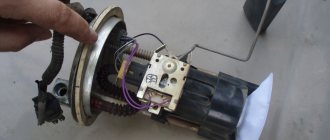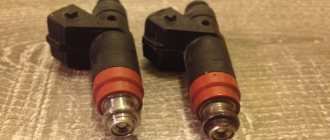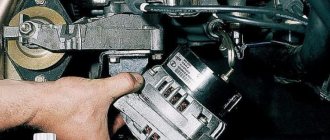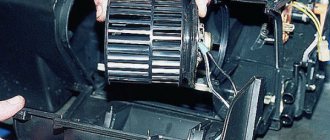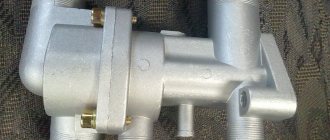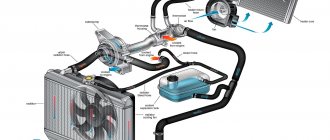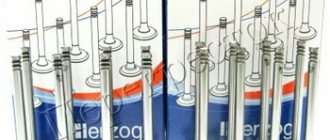During the day the car had difficulty starting. After the traffic light I start to accelerate. At speed 3, 50 km/h, the car begins to lose power (it does not accelerate, but rather loses speed), and in second and first gear the same. I lasted about 200 meters at first, then the car stopped altogether. At first it didn’t stall in neutral, it kept it at 900 rpm, and then it completely stalled. Started it again. It starts, but does not respond to pressing the gas pedal. After 30 sec. stalled. Over the last 2 weeks it has happened that the car would stall at speed and in neutral.
Replaced the crankshaft sensor. Sparks are coming to the spark plugs. I set the timing belt marks. Cleaned the fuel pump screen. The pressure at the outlet of the fuel pump is good.
Now it turns out that for some reason gasoline does not reach the injector. (I pressed the nipple on the ramp - gasoline did not flow). The benzo filter was changed 2 months ago. What could it be?
No pressure in the VAZ 2110 ramp reasons
Due to the residual pressure in the rail after removing the nipple, gasoline will splash out.
Pressure in the fuel rail of a VAZ 2110 - pictures and photos.
Removing the fuel rail and fuel pressure regulator of the VAZ-2112 engine.
Removing the fuel rail of the VAZ-2111 engine.
How to measure the pressure in the ramp.
If the regulator is working properly, the fuel pressure should increase by 0.2–0.7 bar (0.
Fuel pressure dsc01374_2.
27 in the figure). It screws perfectly onto the fitting of the “tens” ramp.
Pressure in the fuel rail of a VAZ 2114.
How to remove engine injectors on VAZ 2110, 2111, 2112.
pressure in the VAZ ramp is free. check, pressure, ramp, VAZ, check.
VAZ-2111 engine. Removing the fuel rail.
There is no pressure in the fuel rail of the VAZ 2110.
Fuel pressure control.
Using two 17mm wrenches, disconnect the fuel rail pipes from the hose.
Do-it-yourself fuel rail disassembly diagram for VAZ 2110.
The starter turns, the car does not start - the main reasons.
2. Remove the decorative trim of the engine (see 8.1.4).
There is no pressure in the fuel rail of the VAZ 2110.
While rocking, remove the fuel pressure regulator from the rail.
Removing the fuel pressure regulator.
27 in the figure). It screws perfectly onto the fitting of the “tens” ramp.
Troubleshooting
No pressure in the fuel rail? Causes:
- Clogged fuel filter;
- Clogged fuel pump filter;
- Fuel pump malfunction;
- Malfunction of the fuel pressure regulator (FPR). And with high blood pressure too.
If the pressure in the fuel rail gradually drops, the cause may be:
- leaking fuel pump connections;
- leaking injectors;
- fuel pump malfunction.
Let's check it like this. We clamp the leading rubber hose of the fuel rail:
- the pressure has become stable - the fuel module is leaking or the pump is faulty;
- the pressure drops - the injector(s) are leaking.
Checking the RTD. Connect the pressure gauge hose to the outlet fitting of the fuel pump and turn on the ignition:
- the pressure is low but stable - this means the RTD is faulty and is releasing pressure too intensely.
If the pressure in the fuel rail is within normal limits, we look for the causes of engine malfunctions elsewhere.
Keywords: power system Lada Granta | power supply system for Lada Kalina | power supply system for Lada Priora | power supply system for Lada Largus | 4x4 power system | power supply system for Lada Vesta | power system lada xray | Lada Granta engine | Lada Kalina engine | Lada Priora engine | Lada Largus engine | 4x4 engine | Lada Vesta engine | lada xray engine | Niva power system | Niva engine | universal article
+10
Share on social networks:
Found an error? Select it and press Ctrl+Enter..
No pressure in the fuel rail VAZ 2110 8 valves
The tuning pressure is 6 atm in the VAZ fuel rail, not in order.
There is no pressure in the fuel rail of the VAZ 2110.
Removal and installation of the fuel rail and regulator VAZ fuel 2110, VAZ 2111.
Removing the fuel rail and fuel pressure regulator of the VAZ-2112 engine.
2.17.1.7. Checking and replacing the fuel pressure regulator.
Removing the fuel rail of the VAZ-2111-1 engine.
a special membrane-type valve, on which it turns on one side.
Ramp VAZ 2110 photo.
Pressure in the fuel rail of a VAZ 2110 - pictures and photos.
Checking the pressure in the fuel rail of a VAZ 2109 Do it yourself.
It is installed in the injector rail and represents.
8. Screw in the bleeder fitting until it stops.
DIY car repair. fuel rail. DIY car repair.
diagram for disassembling the fuel rail of a VAZ 2110.
There is no pressure in the fuel rail of the VAZ 2110.
If the regulator is working properly, the fuel pressure should increase by 0.2–0.7 bar (0.
There is no pressure in the fuel rail of the VAZ 2110.
pressure in the VAZ ramp is free. check, pressure, ramp, VAZ, check.
2.1.10 VAZ 2115 timing belt.
Fuel rail - checking operating pressure.
How to remove the fuel rail on a VAZ-2111 car engine yourself.
2. Remove the decorative trim of the engine (see 8.1.4).
Comment on Removing and replacing the fuel rail of the VAZ-2111 engine.
Removing the fuel rail of the VAZ-2112-8 engine.
If the regulator is working properly, the fuel pressure should increase by 0.2–0.7 bar (20.
We move the pressure plate of the fuel supply pipe along the ramp and remove the pipes.
VAZ 2110 low rail pressure
27 in the figure). It screws perfectly onto the fitting of the “tens” ramp.
7. Carefully remove the regulator fitting from the hole in the fuel rail and.
Key words for the article » fuel rail. vase auto repair.
Checking the pressure b in the/bb fuel/bb system/b.
There is no pressure in the fuel rail of the VAZ 2110.
injection regulator setting pressure. I saw only injection ones, races.
fuel pump VAZ 21099 injecto what wire is ground? Its own business.
27 in the figure). It screws perfectly onto the fitting of the “tens” ramp.
Pressure in the fuel rail of a VAZ 2114.
Photo of a malfunction of the VAZ 2110 RTD valve, moto-torg.com.ua.
While rocking, remove the fuel pressure regulator from the rail.
8. Screw in the bleeder fitting until it stops.
How to measure the pressure in the ramp.
VAZ 2110 fuel system diagram
Injectors (1), fuel rail (2), diagnostic fitting (3), adsorber (4), check valve (5), throttle assembly (6), gravity valve (7), safety valve (8), separator (9) , filler pipe (10), fuel filter (11), fuel supply line (12), fuel line hose that connects the fuel module outlet pipe and the fuel filter (13), fuel module (14), fuel tank (15), fuel drain line ( 16), fuel pressure regulator (17).
VAZ 2110 no pressure in the rail
Pressure in the fuel rail of a VAZ 2114.
2. Remove the decorative trim of the engine (see 8.1.4).
Pressure in the fuel rail of a VAZ 2110 - pictures and photos.
How to measure the pressure in the ramp of a VAZ 2110.
VAZ-2111 engine. Removing the fuel rail.
Removing the fuel rail and fuel pressure regulator of the VAZ-2112 engine.
How to measure the pressure in the ramp of a VAZ 2110.
diagram for disassembling the fuel rail of a VAZ 2110.
7. Carefully remove the regulator fitting from the hole in the fuel rail and.
How much antifreeze is needed for a VAZ 2110.
The car arrived for firmware adjustment, and the pressure in the fuel rail was 6 atmos.
8. Screw in the bleeder fitting until it stops.
Removing the fuel rail of the VAZ-2111 engine.
Key words for the article » fuel rail. vase auto repair.
Using a 24mm wrench, unscrew the nut securing the fuel return tube.
We move the pressure plate of the fuel supply pipe along the ramp and remove the pipes.
There is no pressure in the fuel rail of the VAZ 2110.
If the regulator is working properly, the fuel pressure should increase by 0.2–0.7 bar (0.
Fuel pressure control.
While rocking, remove the fuel pressure regulator from the rail.
How to measure the pressure in the ramp of a VAZ 2110.
pressure in the VAZ ramp is free. check, pressure, ramp, VAZ, check.
injection regulator setting pressure. I saw only injection ones, races.
Fuel rail VAZ 2110 VAZ 2111 VAZ 2112 - checking operating pressure.
There is no pressure in the fuel rail of the VAZ 2110.
Fuel pressure dsc01374_2.
Fuel rail - checking operating pressure.
What should be the pressure in the VAZ-2112 16 valve ramp: photo
In order to find out more about the pressure in the fuel system of your car, you need to go to a car repair shop and pay 500 rubles. Or you can purchase a fuel pressure gauge and adapter for about 1,500 rubles and do this whole operation yourself. And you can also farm! More details below.
The video below measures the pressure in the fuel rail using a conventional tire pressure gauge:
Measuring pressure using improvised means
Homemade design for measuring pressure in the fuel rail using a conventional tire pressure gauge
It’s easy to measure the pressure using available tools; you just need to have a regular tire pressure gauge on hand (which is used to monitor tire pressure - approx.). All you have to do is follow our instructions exactly. We will tell you how to carry out this operation correctly, and what the correct pressure should be in the fuel rail of the VAZ-2112.
What should be the pressure in the VAZ-2112 ramp?
The operating pressure in the ramp should be in the range of 2.8–3.2 bar (2.8–3.2 atmospheres).
Preparatory work
- We take a pre-prepared pressure gauge, and to prevent fuel spills and air leakage, we wrap flax or fum tape around the tip.
- We are preparing a hose with a maximum internal diameter of 9 millimeters, and clamps will be needed to secure them.
- We place the prepared rags on the engine in such a way that the hose and pressure gauge fixed on it cannot roll off the surface. This is done to prevent excess fuel from spilling over the surface of the engine.
- We wrap flax or tape around the pressure gauge, then fix the hose on it and tighten everything with a clamp.
- On the ramp, unscrew the spool valve from the nipple (in this case, fuel splashes are possible due to the presence of residual pressure - approx.).
A regular wheel cap came in handy.
We put a hose with a pressure gauge on the ramp connections and secure everything with a clamp.
Pressure gauge with pipe assembly.
We place the pressure gauge on a previously prepared rag, and the preparatory work can be considered completed.
Measurement procedure
Before you start working, you can try to relieve the pressure in the fuel system. To do this, remove the fuel pump fuse (which is located on the right side of the panel, under the front passenger’s left foot - approx.). Where 3 relays and 3 fuses are located. In the photo below it is located under the number “5”. After removing the fuse, turn on the ignition and check by ear that the fuel pump is not pumping. We start the car and wait for the engine to stall.
- After everything is ready, we check the already attached end of the pressure gauge with the hose for a secure connection.
- Next, start the engine and look at the readings that appear.
Thus, we diagnose the results that appear and compare them with the results of the norm.
After all the work has been done, unscrew the hose with the pressure gauge, screw in the spool and return everything to its original state.
Note!
The peculiarity of measuring pressure using a pressure gauge is such that its initial value on the scale has a certain inaccuracy. That is, when the air analogue has a measurement period of 15-20 atmospheres, and for fuel control the required maximum value is 5-7 atmospheres, then all measurements taken will have an error equal to the initial values on the device. Therefore, pressure testing should be carried out on a pressure gauge with maximum values of up to 8 atmospheres.
How to check the fuel pressure on a VAZ-2110?
Fuel pressure is an important parameter that needs to be given special attention and kept under control. Its value directly affects the efficiency of the engine, its power, and behavior in different modes. Therefore, a good driver should check the pressure from time to time. All that remains is to find out how to do it correctly.
Features of measuring fuel pressure on a VAZ-2110
I would like to immediately note that this parameter can be measured in several ways. One of the most popular is to purchase a special kit, which includes a special adapter for connection, a pressure gauge (it is with this that the measurement is made), as well as a drain. You will have to allocate about 1,500 rubles to purchase such devices. You can do it differently - go to a service station, where specialists will carry out the necessary measurements for 300-500 rubles.
But there is a more sophisticated method that does not require additional costs - measuring fuel pressure using a regular pressure gauge, which is used to check tire pressure. In this case, for measurements it is better to use pressure gauges with a minimum limit (about 6-7 atmospheres). In this case, the error will be minimal.
But how to check? The sequence of actions will be as follows:
- Prepare a pressure gauge with a limit of 6-7 atmospheres and wind the foam directly under the pipe.
- Prepare an oxygen tube with a diameter of 9 mm and put it on top.
- Secure the fasteners on both sides with clamps.
- Cover the generator with something to prevent fire.
- Reduce fuel system pressure to a minimum. It's easy to do. Remove the fuse that powers the fuel pump (in the “ten” it is located under the trim near the control unit, on the far left side), start the engine and wait until it stalls.
- Twist off the plastic cap installed on the fuel rail.
- Look inside the cap - there will be a standard hole and nipple. Take the cap from the car wheel and unscrew it. Be prepared for a slight surge of fuel (this is caused by residual pressure).
- Now put the second edge of the hose onto the ramp outlet and then secure it with a clamp.
- Remove the “protection” from the generator and start the engine (don’t forget to put the fuse back in place).
This method of checking fuel pressure is considered one of the most accurate, simple and very effective. By the way, if you don’t have clamps at hand, you can use special bushings for the adjusting bolts to tighten them. In this case, a small rubber ring is put on the fitting for fixation. From the back of the sleeve you can solder a fitting to which the hose will be connected.
Normal fuel pressure should be between 2.8 and 3.2 bar (atmospheres). After removing the vacuum tube from the fuel pressure regulator, the readings may increase slightly - by an average of 0.2-0.7 atmospheres.
Checking pressure in systems without return
On VAZ-2110 cars with a volume of 1.6 liters, the pressure indicators in the ramp are unchanged and are at the level of 3.6-4 bars. In this case, measurements are most often made according to the same principles as described above. But there are a number of other non-standard methods:
- Prepare the structure mentioned above - a hose with a pressure gauge at the end. The diameter of the hoses should be somewhere around 7.5-8 millimeters. Measurements must be taken at the outlet of the fuel pump module. A pressure of five to seven atmospheres can be considered a normal parameter.
- Remember how the run-in period is closed on engines with a drain frame. In this case, it is advisable to turn off the engine directly at the gasoline pump. The double hose must be removed and a plug inserted (you can use the “nipple” from an old fuel filter). In turn, a single tube must be pulled onto the pump fitting, and measurements must be taken directly on the ramp.
Diagnostic features
It is important to understand that fuel system malfunctions primarily manifest themselves as sudden “dips” when high engine speeds are reached. In addition, when moving, the car may begin to jerk, it “stumbles” while accelerating, and so on. In such a situation, a mandatory pressure check is necessary. Only after this can the main causes of the problems be identified - filters, injectors, fuel pump, and so on.
Let's take a quick look at how the system works. Everything is simple here. The task of the gas pump is to pump up fuel (which it actually does successfully). Excess gasoline flows through the fuel pressure regulator in the opposite direction. In this case, the gasoline pressure in the rail can change mainly from pressing the gas pedal. As soon as the engine is stopped, the pressure gradually decreases. This can take 5-10 minutes or 5-6 hours (it all depends on the quality of fixation of the valve itself).
Rail pressure VAZ 2110 8 valves
Checking the pressure in the fuel system.
If the regulator is working properly, the fuel pressure should increase by 0.2–0.7 bar (20.
Ramp VAZ 2110 photo.
injection regulator setting pressure. I saw only injection ones, races.
fuel pump VAZ 21099 injecto what wire is ground? Its own business.
How to measure the pressure in the ramp of a VAZ 2110.
2.17.1.7. Checking and replacing the fuel pressure regulator.
Due to the residual pressure in the rail after removing the nipple, gasoline will splash out.
Fuel rail - checking operating pressure.
pressure in the VAZ ramp is free. check, pressure, ramp, VAZ, check.
27 in the figure). It screws perfectly onto the fitting of the “tens” ramp.
Pressure in the fuel rail of a VAZ 2114.
Removing the fuel rail of the VAZ-2111 engine.
8. Screw in the bleeder fitting until it stops.
Fuel pressure regulator 2110.
Checking and replacing the VAZ 2110 fuel pressure regulator.
If the regulator is working properly, the fuel pressure should increase by 0.2–0.7 bar (0.
There is no pressure in the fuel rail of the VAZ 2110.
The car arrived for firmware adjustment, and the pressure in the fuel rail was 6 atmos.
VAZ fuel pressure.
2. Remove the decorative trim of the engine (see 8.1.4).
If the electrical circuit in a VAZ 2110-2112-2170 car is obviously in good working order, and the pump hums as usual, this does not mean that gasoline is supplied to the injectors as normal. No! There may be some problems here.
Let's start with the most basic.
For what reasons is fuel not supplied to the cylinders?
So, the general scheme of operation of the power system involves taking fuel from the gas tank, after which the fuel enters the carburetor or injector.
Next, the fuel is supplied to the intake manifold, then the fuel-air mixture enters the combustion chamber through the intake valves.
It becomes clear that if gasoline does not flow into the engine, then this problem occurs both on engines with a carburetor and on injection internal combustion engines. The simplest reason can be considered a lack of gasoline in the tank or damage to the fuel lines. In other words, we are talking about leaks as a result of any damage to the tank or fuel lines, when gasoline leaks out before it gets into the cylinders.
Common problems with the supply of gasoline to the internal combustion engine
- If we exclude leaks, the next reason why gasoline is not supplied to the engine is various problems with the fuel pump. Note that on cars with a carburetor there is a mechanical type fuel pump and is located in the engine compartment.
At the same time, injection engines have an electric fuel pump. This pump is located directly in the fuel tank. If we talk about a mechanical device, then often its breakdown or incorrect operation results from damage to the membranes, as well as overheating.
The electric fuel pump usually fails in cases where it operates with a minimum amount of fuel in the tank. The fact is that cooling of this type of pump occurs precisely due to fuel. You should also highlight problems with the fuel pump relay or a break in the wiring through which it is supplied with electricity.
Let us add that if the device is not able to create the required pressure in the fuel system (no or low pressure), then the injectors on some internal combustion engines may not open, and in this case the engine will not start. In other cases, the injectors still open, but there is still not enough fuel. In this case, the unit begins to work intermittently, stalls in different modes, etc.
At the initial stage, it is necessary to measure the fuel pressure in the fuel rail of an injection engine, while at the same time not forgetting about possible problems with the pressure regulator in the rail.
- Another problem that prevents fuel from getting into the engine cylinders is dirty fuel system filters. In addition to the usual fuel filter, the injector also has a fuel pump mesh, and in the event of severe contamination of the fuel pump mesh filter, the performance of the device drops noticeably.
If the fine fuel filter becomes dirty, then the flow of fuel into the engine can be completely blocked. As for the carburetor, these cars also have a fuel filter, which is usually installed in front of the carburetor. If the filter element becomes clogged, then difficulties begin with starting the engine and supplying fuel in different modes.
To avoid the above problems, filters must be changed promptly on both carburetor and injection engines. You also need to remember that the filter mesh on the fuel pump needs to be periodically cleaned or completely replaced with a new one every 50-60 thousand km. mileage
- The list of possible causes of a malfunction in the fuel supply to the engine ends with contamination of the carburetor or injection nozzles, as well as failure of individual elements. As a rule, the jets in the carburetor can become clogged, and the nozzles in the injectors are subject to contamination. Debris and deposits may also partially or completely block thin channels, etc.
We also recommend reading the article on how to clean the fuel pump mesh. From this article you will learn about the signs that indicate the need to clean the element, as well as how to clean the fuel pump mesh filter with your own hands.
To prevent this from happening, the injector must be periodically cleaned using one of the available methods (ultrasound, special cleaners on a bench, etc.). It should also be added that the carburetor may require cleaning, repair or separate tuning. For example, an insufficient amount of gasoline in the float chamber will result in insufficient fuel for normal operation of the internal combustion engine.
Checking the fuel rail pressure
First, remove the protective cap of the fitting (as shown in photo 1).
Be sure to place a cloth underneath so as not to splash the engine compartment with fuel, and use the tip of a thin slotted screwdriver to press on the spool of the fitting. If the stream of fuel is thin or weak, this means low pressure in the fuel rail - you need to look for the cause. If gasoline sprays with strong pressure, then there is hope that the pressure is within normal limits (2.8-3.2 bar), but to be sure, you need to measure it with a pressure gauge. At the service center this is done using fuel pressure gauges with adapters. We will use a simple one from a tire pump. The only main thing is that the measurement limit is at least 4 bar. You will need another part of a gas-resistant hose, the length of which should be 150 millimeters, the internal diameter of which should be 10-12 mm, as well as 2 more clamps.
Use the wheel valve cap to unscrew the spool valve from the fuel rail fitting. We put the pressure gauge hose on the fitting and tighten it with a clamp. We turn on the ignition, without starting the engine: after 2 seconds, the gasoline pressure in the rail should increase to 2.8-3.2 bar and remain at this level (photo 3).
If it is significantly lower (about 1 bar) and remains at this level for a long time, you need to check the supply line 4 - most likely, it is clogged. There are 2 problem areas: fuel pump mesh 2 and fuel filter 5.
Cleaning the fuel pump mesh
We take the fuel pump out of the tank, remove the screen and wash it. Before installing the fuel pump, it would be a good idea to check it for leaks and the reliability of the connection of its tube (arrow in photo 5) to the fuel line.
You will certainly ask what to do if the supply line is clean, the pump is humming, and the pressure is still below normal. In this case, you need to change the pump itself - it has exhausted its service life! Or it may happen that the pump seems to be functioning normally, but there is no pressure in the rail! This can happen in winter if there is a lot of water at the bottom of the fuel tank. When the grid freezes, it interrupts the flow of fuel to it. What should I do? Lighting a fire under a gas tank, heating it with a blowtorch or some other source of fire - this should not be done under any circumstances. It is preferable to remove the fuel pump and clear it of ice. The second option is for those in no hurry: roll the car into a warm room and wait... Then it would be a good idea to drain the water from the fuel tank. It's a troublesome task, but a rewarding one.
Possible faults
The fuel supply line is clogged, how to remove the blockage
A malfunction of the sensor that regulates the fuel pressure just before injection and a clogged fuel line can also cause low pressure. To reliably find out the reason why the pressure is jumping, it is necessary to perform competent measurements. First measure the pressure of the pump, then the line, and then check the pressure in the rail itself. This will allow you to find the specific cause.
clogged fuel injectors, how to fix them
There are a number of symptoms that can indicate that the fuel injectors are dirty:
- Difficulty starting the engine.
- Unstable engine operation.
- Dips when pressing the gas pedal sharply.
- Loss of power and deterioration in acceleration dynamics.
- Increased toxicity of exhaust gases.
- Increased fuel consumption.
- The occurrence of detonation.
- Popping sounds in the exhaust system.
- Misfires.
The malfunction can be resolved by cleaning the fuel injectors.
the valve is clogged, how to check and fix it
If the valve is clogged, fuel flows too tightly, causing it to leak out everywhere. If you notice that fuel consumption has increased significantly, change the regulator, since it is the leading component - the valve becomes completely clogged and fuel is not supplied to the supply system.
the valve is stuck, how to check and fix it
If the pressure in the system is uneven, this is usually caused by a stuck valve. In this case, the car has an uneven ride and jerks or stalls altogether.
Spark Plug Inspection
If the spark plugs are wet, then gasoline flows. Dry? In this case, you need to check the signal at the harness connector of the mechanical liquid or gas atomizer (injector) with a probe (as shown in photo 6).
Did you do it, but the spark plugs are still dry? Then you will have to unscrew the screws securing the ramp and lift it under the intake manifold so that the injector nozzles can be seen. We turn on the ignition and turn the engine crankshaft with the starter. If there are no streams of fuel, you need to remove the injectors and most likely replace them with new ones. True, almost every serious service will recommend that you wash them.
If the price of a new set of injectors is slightly higher than flushing, then you should choose a replacement. Injectors also experience age-related problems. Also read:


